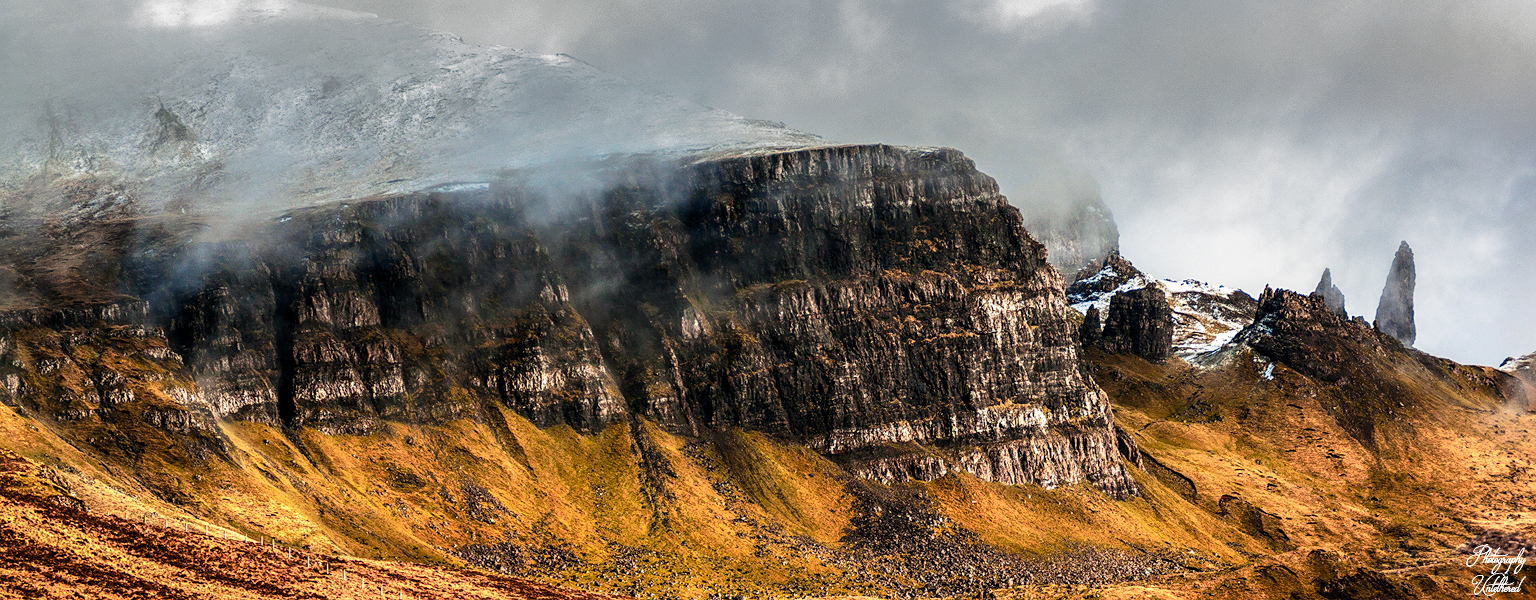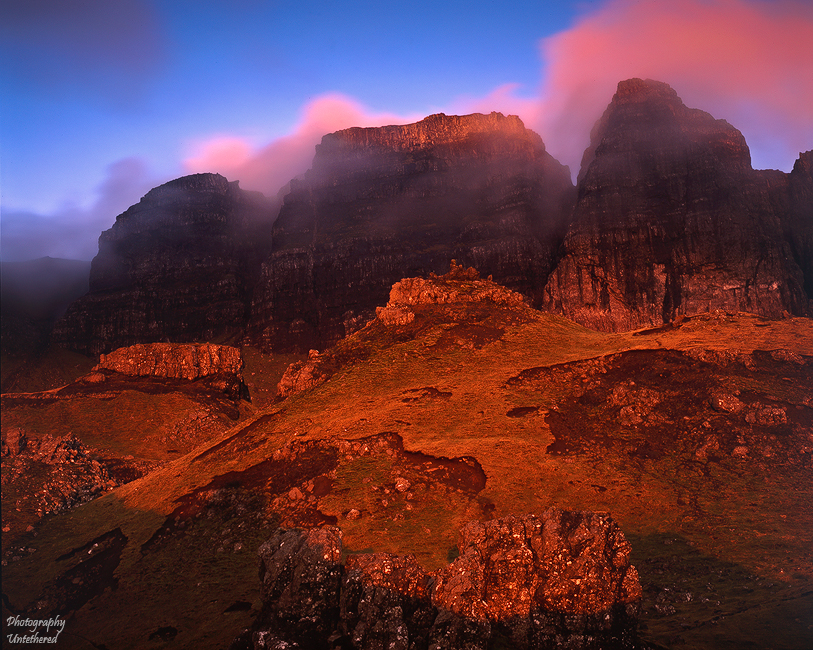The Storr: Skye’s Iconic Landscape
The Storr is the highest point of the Trotternish ridge, rising dramatically in a sheer black cliff that reaches 2,360 feet above sea level. Standing prominently on a high ridge are several pinnacles, with the Old Man of Storr being the most notable. Most of the main hill names on the Isle of Skye have Norse origins. The word “Storr” originates from Old Norse; in Norwegian, it means “big.
Nevertheless, it could also be of Gàidhlig origin, as the impressive rock formation known as the Old Man of Storr may have inspired its name, as “Ficaill Stòrach” in Gàidhlig can translate to “broken tooth” or “buck tooth.” The Old Man of Storr definitely looks like a tooth. Here on the Trotternish peninsula of Skye, the cataclysmic forces of nature have left their mark. Indeed, one is transported to a prehistoric world, and Pterodactyls would not look out of place perched high on the Storrs precipitous cliffs.
Trotternish or Tròndairnis in Gàidhlig, is the northernmost peninsula of Skye. Like Skye’s Cuillin ridge, the name “Trotternish” originates from Old Norse, meaning “Thrond’s Ness.” The term “Ness” comes from Germanic origins and refers to a point or headland. This etymology highlights the historical Norse influence in the area, similar to the naming conventions found in places like Trondheim in Norway.
The ridge, forming the peninsula’s spine, is most dramatic on its east side; both in scale and character, there is nowhere like it anywhere in the British Isles. Set against a backdrop of harsh, barren, windswept bog and heath, the combination of high cliffs, terraces, pinnacles, and unusual rock formations creates a masterpiece of natural architecture.
One Christmas many years past, I stayed just north of The Storr. Early one dawn, I ventured to capture the sunrise there. That morning, I was the only one about (something of a rarity now). After a forced march up the track, I remember the airy scramble on loose, unstable ground, with a heavy tripod and old medium-format film camera to get a composition.
I was a novice photographer and not entirely competent with the tools at my disposal. Fuji Velvia 50 120 transparency was then my favourite film. Remember when you had to wait a couple of weeks to see the results of your work? I recall the anticipation of reaching for the lightbox when the post arrived. For me, nothing in digital photography can surpass that feeling when you first see a great image on transparency.
God’s Celestial Fire: A Captivating Spectacle of Heavenly Brilliance!
I digress. True to form, God’s celestial fire lit up the high crags of The Storrs’ colossal buttresses. As if by magic, swirling clouds of vapour swept around the buttresses and into and through the deep gorges. Akin to some supernatural force from “The Lord of the Rings”, this winding, coiling, snaking form hunted out its prey. The mist, catching the sunlight, produced a beautiful pink hue. Under the duress of panic and excitement, I struggled to capture this sublime, awe-inspiring sight. Furthermore, there was the realisation that I was the sole witness to this wondrous, divine display of Heavenly brilliance.
My inexperience proved later: in a series of transparencies that were more often than not, underexposed and out of focus. Notwithstanding, was it even possible to convey through photography my experience that dawn?
Much has passed in my life since that morning. Although the memory and emotions of that sunrise fragment with every passing year, this is one experience reluctant to leave me. I wonder if — subconsciously —photography is a vain attempt to capture and bottle time? To desperately cling to a present moment as it is inevitably dragged into the past.
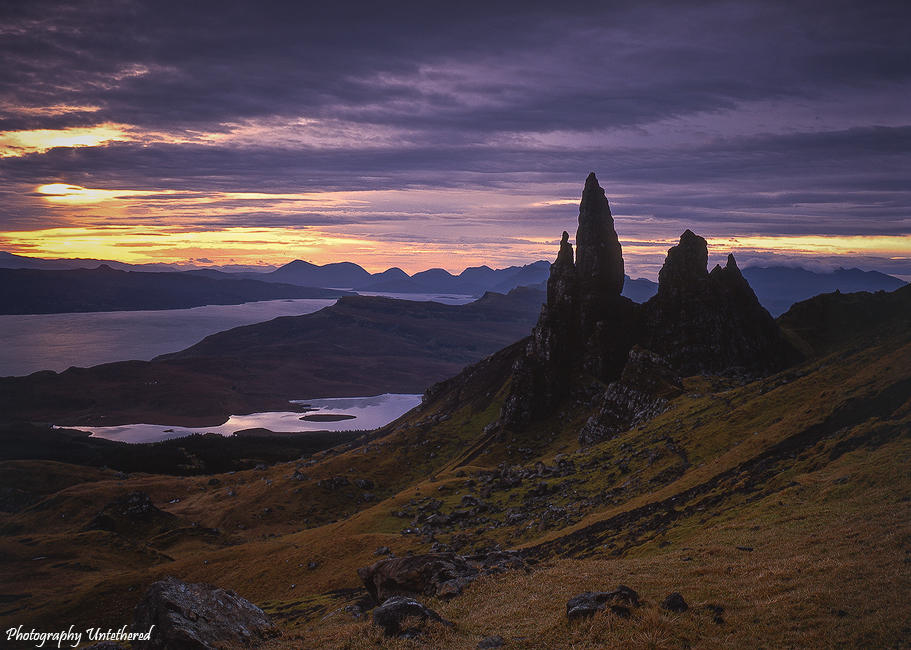
The Old Man of Storr, the Isle of Skye’s Iconic Rock Pinnacle:
In the far right of the main panoramic image, a teetering rock pinnacle stands in stark isolation. The Old Man of Storr rises precariously 50 meters above its base. This flaky, megalithic obelisk proudly occupies “The Sanctuary”, surrounded by its satellites. At its base, its circumference is undercut, allowing the Old Man to balance precariously against the forces of nature that slowly erode its dominance. In geological terms, it stands aloof for only a brief moment, and how fortunate we are to be here now, during a time of relative freedom and technology that allows us to visit, marvel at, and photograph this wondrous vista.
The Storr is the most prominent feature of the ancient Trottenish landslip. The longest and largest anywhere in the British Isles. Over time, a total of 24 lava flows, approximately 300m thick, caused the underlying Jurassic sedimentary rocks to shear along the north-south fault lines. Colossal blocks then slid seawards, revealing the Trottenish ridge we see today. The Storr, over millennia blasted by wind and rain, riven by ice and frosts, formed chasmic gullies. The Storr is a wondrous creation of nature. Travelling the road north from Portree, its looming prominence soon stands guard through this barren wilderness of bog and heath.
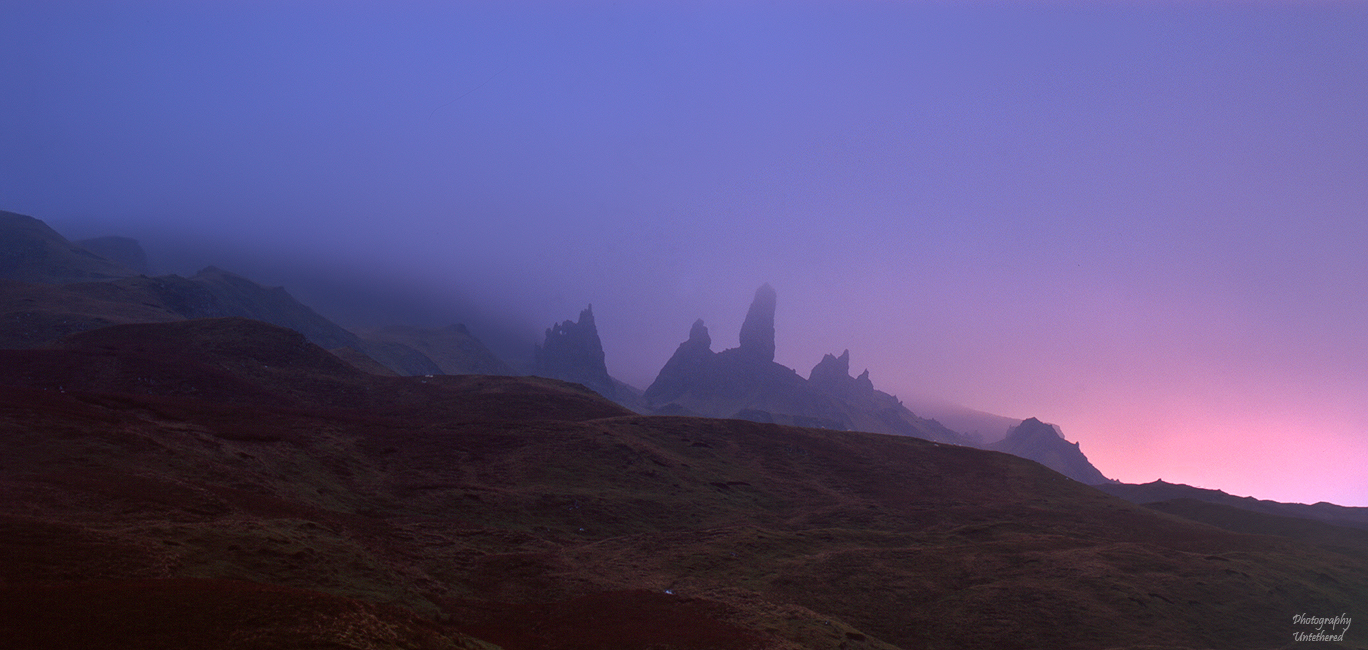
Skye’s Most Photographed Natural Landmark:
The main image was taken on the approach to the Storr from the route just described. I took a boggy passage over moorland to gain some elevation. This day in April had everything: snow, sun, hail and showers. That far north, although taken during the day, the sun’s elevation is still low enough to give attractive light.
Snow swept over the Bealach Beag — the monolithic Old Man enveloped by snow showers, faded in and out of view, like some ghostly apparition. The Gods were kind that day. Sunlight beamed upon the precipitous cliffs of Trottenish. I could take my time and shoot a few images under varying conditions. A few people stopped and headed in my direction, the advantageousness of my position from the roadside being obvious. Alas, it was welly country only, and all — on the realisation of their folly — returned to continue their journey north.
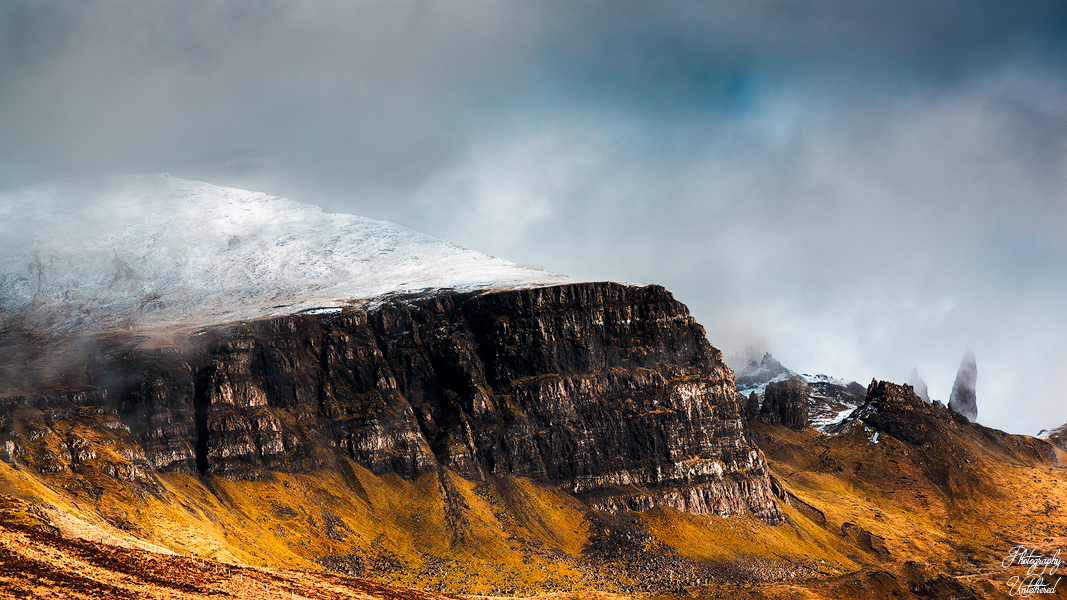
Over many years of landscape photography, I have found the telephoto zoom lens the ideal tool. I take and use little else now. I may, at some point, buy a prime wide-angle lens, but for now, I do not feel the need. The 1st image shows the advantages of such a lens.
The Storr and, more specifically, the Old Man, are well photographed. Is this a bad thing? Providing we can visit these spectacular, fragile locations — and tread lightly — I would say no. Furthermore, it is those classic shots that draw us to those locations. Through his books and pictures, Wainwright drew attention to the beautiful Lake District and Highlands; the trade-off, however, was that he invited what he hated: tourism.
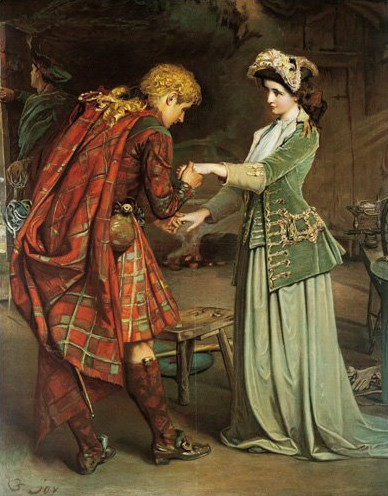
A Changing Skye:
Skye has changed significantly since I first visited: much of the adventure in its remote inaccessibility has been lost. Like everything else, there are trade-offs. Local businesses have thrived since the ease of access with the Skye Bridge. I once contemplated buying the Glenelg-Skye Ferry to operate, although, foreseeing the potential loss of business due to the Skye bridge, I decided against it. Glad to say the Glenelg-Skye Ferry is still in operation.
With the introduction of the internet, and specifically Airbnb, Skye’s tourism has gone through the roof. Much local rental accommodation has been given over to Airbnb’s lucrative trade. Many would not travel to Skye in case the B&Bs were full. Now, however, you can book a place via a mobile device. One consequence of this is a significant increase in people and cars. Furthermore, this has reduced available rental property for locals. Many natives of Skye will inevitably be forced onto the mainland, and more local culture will be lost.
Once a distant island only accessible by boat. Skye, over time, has become a victim of its own success. With the march of time, change is inevitable, no matter how we wish otherwise.
CL Warr wrote of this anguish 1928: “A century ago, not a word of English was spoken in that Clachan of the west. Today the old language of the Gael is dead. A brief century has worked the change and scattered the mystic Celtic atmosphere with the rude blasts of modern life and civilisation”

The Illusion of Time: The Mind-Bending Truth
The reality is that land can never belong to a people or culture. It is an illusion of human time that makes us think this is so. And why we are reticent to face reality. So we struggle in vain to hold onto what has passed. Only in the last 13,000 years of geological time have the human species consistently inhabited the British Isles. Before that, a struggle of one million years ensued in an attempt to gain a foothold in these ancient lands. At one point, the climate changed, and the temperature plummeted — the intense cold made these isles uninhabitable for 100,000 years!
The Storr has witnessed many changes in Skye over millennia. It was there before the first Mesolithic hunter-gatherers. Before the settlement, growth, and abandonment of many early communities. Before the Clach Ard Symbol Stone and Brochs of the mysterious Pictish communities. Before the Norse peoples who left place names. It witnessed St Columba and the rise of Christianity; the rise, struggle, and decline of the Clans — and the wretched highland clearances. The Storr has seen many changes.
The Future of Skye:
The inhabitants of Skye, even in relatively modern times, have remained close-knit and quite isolated; this isolation has slowed the pace of civilisation. Now, with the Skye bridge, the ease of access has broken down that isolation. The internet, however, brings rapid changes never seen before in human history. The once-isolated cultures and communities of Skye are no longer. Much of the old language is gone forever. Its remote wilderness is no longer so lonely – its hidden gems no longer so secret. Whatever the future holds for Skye over the next century and beyond, one thing is guaranteed: The Storr will remain dominant long after human settlement ceases, until finally, the Storrs’ time is up.
Green wind from the green-gold branches,
what is the song you bring?
What are all songs for me, now, who no more
care to sing?
Deep in the heart of Summer, sweet is life to
me still,
But my heart is a lonely hunter that hunts on
a lonely hill.
| William Sharp
Getting There (2025)
By Car: The most common way to reach the Old Man of Storr is by car, driving along the A855 road from Portree towards Uig. The journey from Portree takes about 14 minutes. There is a large, 140-vehicle car park located just north of Loch Leathan, by the side of the main road. Parking costs £6 for up to 6 hours and £7 for up to 12 hours, payable by coins or contactless card. During peak season, especially between 10 AM and 3 PM, the car park can become very busy, often overflowing, with cars parking along the road shoulders. Arriving early in the morning, ideally before 8 AM, is recommended to secure a parking spot and avoid crowds.
By Public Transport: Stagecoach bus services (57A and 57C) stop at the Old Man of Storr, offering an alternative for those without a car. The fare from Portree is approximately £3 each way. However, bus services are infrequent, and it’s advisable to check the up-to-date timetable on the Stagecoach website or with the Visitor Information Centre in Portree due to potential cancellations or schedule variations based on school holidays and days. Taxis are also an option from Portree, costing around £18 one way, but they are limited and should be booked in advance.
The Hike
The hike to the Old Man of Storr is an out-and-back trail, covering a distance of approximately 3.8 km (2.4 miles) round trip, with an average completion time of 1 hour 15 minutes without stops. The trail is generally considered of medium length and average difficulty, with a consistent uphill climb. The elevation gain is around 205 meters (700 feet) to 335 meters (1,100 feet), depending on the specific route taken to the viewpoints.
Trail Description:
- Stage 1: The walk begins through a metal gate near the car park, following a gravel path that snakes uphill through an area that was formerly pine woodland. There are two path options that rejoin later; the right-hand side is slightly shorter.
- Stage 2: The path continues uphill, becoming rockier and passing through another gate near a small pond.
- Stage 3: The trail features steep, uneven rock steps, requiring careful traversal, especially in wet conditions. As you ascend, the Old Man pinnacle becomes visible on your right.
- Stage 4 (The Pinnacles and Viewpoints): The path leads between the Old Man and Needle Rock (also known as The Cathedral), allowing close-up views of these formations. For the most stunning panoramic views, continue uphill to the area known as Photographer’s Knoll and the trig point. This section offers breathtaking vistas of the Islands of Raasay and Rona, the Scottish mainland, the Trotternish Ridge, the Quiraing, and the Storr Lochs and Portree to the south.
Difficulty and Conditions: The trail is primarily a gravel path, but sections can be steep and include rough stone steps. The upper parts can become muddy and slippery after rain, and there is a risk of rockfall at higher elevations. Appropriate sturdy footwear, such as hiking shoes or boots, and suitable clothing for changeable weather are highly recommended.
Tips for Visitors
- Best Time to Visit: Early morning (before 8 AM) or later in the day is best to avoid crowds, especially during peak tourist season (July and August). The period between 10 AM and 3 PM is the busiest. For photography, sunrise is ideal as the sun lights up the eastward-facing rock formations.
- Weather: Skye’s weather is unpredictable, with sudden mist and heavy rainfall common. Be prepared for all conditions with waterproof layers and warm clothing. If it’s raining, patience is key, as showers often pass quickly, leaving clearer views.
- Amenities: The car park has a toilet, motorhome waste facilities, and bike parks. Storr View Coffee, across the road, sells snacks and drinks. A small souvenir shop and ranger station are also available.
- Responsible Tourism: Visitors are asked to stay on marked paths, keep dogs on leads, avoid open fires, and take all litter home to protect the site from erosion.
“Take only memories, leave only footprints.”
The website is self-funded, and my work is free. All profits from the sites product links go to SightSavers; if you have enjoyed any aspect of this site please consider a donation here. No one should go blind from avoidable causes. How many people’s sight will you help us save today?
Fragmented Memory 🙂
